Why First Aid for Complementary Therapists is so Important
Edited: July 18, 2024
As a therapist – or any other type of business owner, large or small – you are responsible for the health and safety of your employees and your clients whilst they are in your care or use your products.
You have a duty of care to all your clients and staff to keep them safe. The law requires you to cut the risks of your staff and clients of getting ill or injured, so understanding health and safety is very important. Part of this is the ability to recognise symptoms and give emergency first aid when required.
Understanding the provision of potentially life-saving emergency care and first aid is vital for every complementary therapist. You may be treating clients with an underlying and unrecognised heart disease; raised blood pressure and cholesterol; allergies leading to anaphylactic shock; brittle bones (e.g. due to osteoporosis, or steroid use); anaemia (e.g. due to menopausal problems); challenged adrenal function (e.g. due to steroid use) and any number of other common conditions like brittle asthma or epilepsy and even panic attacks which can present sudden and critical symptoms during treatment.
It is your duty as a therapist to be prepared to recognise and apply emergency first aid until NHS first responders arrive.
The UK law applies to all businesses, large or small. If you’re self-employed or an employer of even a small staff, you are responsible for the health and safety of your business. The law is there to make sure you have a safe working environment to cut down the risk of you, your staff or clients getting ill or injured. So, by law you must be aware of health and safety risks to you, your staff and your clients and this includes giving first aid.
As an employer you must appoint someone who knows about health and safety. This could be yourself, if you have a health and safety qualification, knowledge and experience; one or more of your staff, if they are qualified or you get them trained; or even someone from outside the business. If you’re not confident about managing health and safety in-house then you probably need to call in some external help or advice.
Even if you don’t employ any staff, don’t forget that legally you have what’s called a ‘duty of care’ to anyone who is affected by what you do for a living – even members of the public who might be affected by what you do. For example, someone who feels that their parent, child or partner has been badly affected by your care, might decide to pursue a claim in court.
Our advice is always to keep up-to-date with health and safety regulations – remember that they are there to protect you, your staff and your clients.
Using Carrier Oils in Aromatherapy
Edited: November 13, 2022

It is a general rule in Clinical Aromatherapy that applying pure essential oils without a carrier, is unsafe practice. The well-trained Clinical Aromatherapist is aware that there are a few exceptions to this rule, but even ‘safe’ oils like Melaleuca alternifolia (tea tree) and Lavandula angustifolia (lavender) can trigger a lifelong sensitivity. This highlights the importance of using essential oils under the guidance of a professionally trained Clinical Aromatherapist.
Therapeutic Essential Oils are Powerful.
Any essential oil could cause an allergic reaction if applied undiluted. For those interested in reading more about these dangers Marge Clark writes about her own ongoing personal battle with dermatitis following exposure to lavender oil in her book Essential Oils and Aromatics.
Using Carrier Oils.
Safe practice means treating essential oils with respect and diluting them with a carrier oil: so-called because they carry the essential oil onto or into the skin. All carrier oils are easily absorbed, have a mild or no aroma and are non-volatile. These oils nourish the skin and tissues and if chosen carefully enhance the healing properties of the essential oils.
With the wide range of non-volatile plant oils available, it is surprising to discover that many aromatherapists limit themselves to using grape seed or almond oils. Your choice of carrier oil can make a significant difference in the therapeutic properties, colour, aroma and even the shelf life of your final product. Unlike essential oils, carrier oils can go rancid over time which is why the clinical aromatherapist will generally create the bespoke oil or lotion for each client. You might choose an unscented carrier (like grape seed), lightly scented (such as coconut and jojoba) or more heavily scented (olive and argan for example) – each carrier oil bringing its own unique properties to the blend.
Essential oils are generally diluted at 2% by volume with the carrier oil for adults and at 1% for children and elderly clients. Following these guidelines should ensure safe topical application of most oils although treatment of children and elderly clients should always be undertaken with utmost care and requires specialised education and training. Higher concentrations can be used – up to 10% with some essential oils – but it is important to understand the potential risks involved. Here the professional Clinical Aromatherapist once again relies on their understanding of the chemical properties of both essential oils and carrier oils and the ways in which they interact.
Carrier oils also have cautions and contra-indications for use and so again should be used under the guidance of a Clinical Aromatherapist. E.g. Hypericum should not be used for clients who are taking certain antidepressants and nut oils should obviously never be used with people who have a nut allergy.
Choosing Your Carrier Oils.
Carrier oils should be cold-pressed and as unrefined as possible, meaning that they retain their aroma and are uncontaminated by bleaches or deodorisers. Some, like jojoba, are actually a form of wax and are useful when overproduction of sebaceous oils is a problem (as in acne). Others, like coconut and olive oils, contain fatty acids, polyphenols and plant sterols which feed and moisturise the skin. Some macerated carriers are either too viscose or too expensive to be used as 100% main carriers and therefore can be added to your main carrier at 25% of your carrier blend.
Whether they are nut oils, seed oils or from other vegetable sources, understanding the constituent elements and effectiveness of each oil enables us to choose exactly the right one as a carrier for each individual application.
Experiment With Different Carrier Oils
Delve into the exciting world of carrier oils and broaden your knowledge as to how they can create balanced and healing massage blends for your clients. Whether using avocado or sweet almond, black cumin seed or tamanu oils, every carrier oil has something unique to offer the professional aromatherapist in their practice.
Beetroot – the purple powerhouse
Edited: November 13, 2022
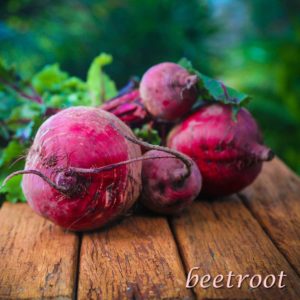
beetroot – the purple powerhouse
Beetroot (or beets, as they are also known) with their sweet, earthy flavour and rich purple colour, are now officially recognised as a ‘superfood’ by nutritionists and other health providers across the world. But are they really as good for you as their current popularity suggests? Or are we just being influenced by good beetroot PR?
Well, the good news is that there are more than a thousand studies worldwide that show the benefits of beetroot. So yes, beetroot really is a fantastic addition to a healthy diet.
Beetroots are high in nitrates and we need nitrates to keep our bodies operating at their best. Nitric oxide is a vasodilator, helping to keep our blood vessels open and relaxing the arteries. By improving blood flow to the heart, the brain and the rest of the body, we lower our blood pressure and the risk of strokes, reduce the risk of heart disease and improve brain function.
We produce less nitric oxide as we age. Eating a varied diet rich in nitrates is an important part of keeping our bodies and minds healthy and active as we grow older. The addition of leafy greens and beetroot guarantees a nitrate rich diet.
Even younger people will benefit from eating a diet rich in nitrates which play such an important role in cardiovascular health. Improved blood flow leads to higher oxygen levels, increased energy and better athletic performance.
Beetroots are high in sugar which you might think makes them less ideal in a diabetic diet. However, the sugars that make up 16% of the nutrients in a beetroot are not readily accessible to our bodies (unlike refined sugars) and they are high in fibre which makes them ideal for diabetics who generally suffer from high blood pressure.
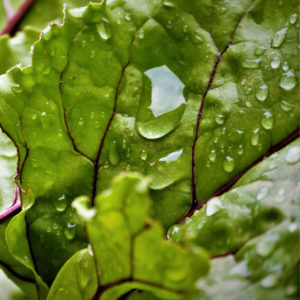
iron and nitrate rich beetroot leaves
Most of us fear the onset of dementia as we get older and here beetroot again comes to the aid of the aging brain. Increasing blood flow to the brain is known to help in the fight against dementia.
Young beetroot leaves are high in iron and nitrates and are a delicious addition to salads or wilted in Asian type bowl foods. Or try this recipe to serve the larger greens with garlic and lemon – delicious!
One word of caution – less is more when it comes to adding beetroot to your diet. While health practitioners suggest a glass of beetroot juice or the addition of beets to your plate every day will have health benefits, don’t overdo it. Nitrates are a valuable addition to our daily diet, but too much can have ill effects, increasing the risk of heart disease and strokes.
So, moderation in all things, but bringing some purple power into your life is just what the doctor ordered.
Ayurveda – the science of nourishing and balancing body and mind
Edited: July 31, 2018
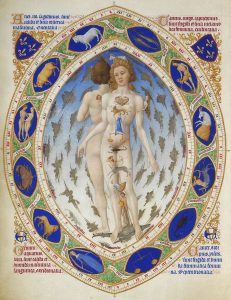
Thousands of years before modern medicine provided ‘scientific evidence’ for the mind-body connection, the healers of the ancient world understood the importance of nourishing and balancing both the physical body and the psyche (mind) in the treatment of illness.
The Greeks, acknowledged as forefathers of modern Western medicine, observed that despite our individual differences, human beings tend to fall into distinct physical and psychic categories corresponding to the four elements: Earth, Air, Fire and Water.
At the same time the Chinese sages recognised 5 elements – Wood, Fire, Earth, Metal and Water – acknowledging the endless cycle which they explained thus:
Wood feeds Fire.
Fire creates Earth (ash)
Earth bears Metal.
Metal collects Water.
Water nourishes Wood.
Meanwhile, more than 5,000 years ago in India there grew the philosophy of Ayurveda (meaning the science of life). Ayurveda is based on the principle of three doshas or different physiological energies that make up every individual. Just as Greek and Chinese healers and philosophers recognised that we are all different and have different physiological needs, so did the Ayurvedic healers and teachers.
This understanding of the unique role of the elements in our individual make-up was prevalent across both Eastern and Western philosophies until recent times and the advent of modern medicine and the introduction of ‘Patent Medicines’ as a commercial, profitable enterprise.
Ayurveda is the essence of the holistic approach to health. In Ayurveda, every individual is unique and for each person there is a diet or lifestyle routine that works. Prevention is key to the Ayurvedic approach. By understanding what our body needs, we can optimise our physical and mental health. Eating well according to our physical needs, exercising or moving in the right way and learning how to reduce stress – these are the foundation of Ayurveda.
Ancient and traditional medicine relied on the observation of individuals within close communities. People were not merely statistics or consumers of commercial products. Somehow we are losing the knowledge of thousands of years of observation in the name of ‘science’.
Science is absolutely the way forward – but a thousand years of acute observation is also science.
Write a review and spread the word about The S.E.E.D. Institute
Edited: October 11, 2018
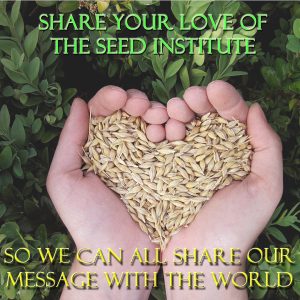 We are celebrating 32 years of sharing the message about holistic healthcare and we would love you to help us spread this message further – educating those who are interested in body and mind medicine.
We are celebrating 32 years of sharing the message about holistic healthcare and we would love you to help us spread this message further – educating those who are interested in body and mind medicine.
People read reviews. But they don’t often think of writing one unless they are asked. By publishing your reviews on Google we get to spread the word about The SEED Institute – it’s so simple.
What is The S.E.E.D Institute?
The S.E.E.D. Institute – Self Exploration Education and Development (TSI) was founded in 1986 by Alison and John Perrott and Su Hagan with the aim of promoting traditional approaches to healthy living.
The original founders have studied a broad range of Eastern and Western spiritual and medicinal practices such as Ayurveda, Herbal and Chinese medicine, Clinical Aromatherapy and Massage, Anatomy and Physiology, Kinesiology and more. John Perrott is a teacher of the Fourth Way and this profound influence built a solid foundation of holism that permeates TSI.
The founders of TSI are committed to the holistic approach to medicine and healing. They understand that the mind body and emotions are inextricably connected and that the mind is a powerful healer of the body.
Underpinning the work of The S.E.E.D. Institute is the knowledge and understanding that we can (and should) learn from the traditional schools of the East who have passed down thousands of years of sacred practice; ancient techniques of working with the whole person – treating the many layers of the body together with the mind and emotions.
Historically, healers and teachers understood that the brain is an organ that controls the body. We can learn to guide the mind and body to relax and regain control of our physical responses to our sensory input. We have lost touch with how powerful our senses of touch, smell, taste and hearing can be because our visual sense is overstimulated, preventing the senses from working together in a balanced way. The idea that our senses are a short-cut to memory and our psyche is something that modern science is only just beginning to understand.
The aim of TSI remains to assist practitioners to be holistic in their perceptions, outlook and practice by offering courses that teach the best of both eastern and western approaches to assessment and treatment.
We have never sought to become a huge commercial corporate organisation – that is not part of the aim or the philosophy of TSI. We offer professional, holistic and fully recognised courses for those seeking to explore, educate and develop themselves and their practice.
Course numbers are intentionally limited to afford students individual support during their studies. We care more about spreading the word about holistic medicine than about making a profit – and that is, and has always been, an important part of our philosophy.
Please help us to spread the word by telling the world about your experience of learning with us. Just type ‘The SEED Institute’ into the Google search engine and add your review.
When we reach 50 reviews on Google, we will put the names of all the reviewers in a hat and draw one at random to receive a free 1-day course of their choice. We truly believe in our message and hope to take it forward to the next generation. Thanks to everyone who is helping us to take our message forward for the next 32 years.
The Extraordinary Intelligence of Your Potted Geranium
Edited: November 13, 2022
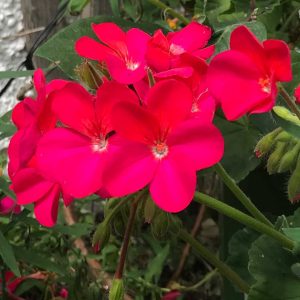 We know them as geraniums. Those glorious bright red staples of our summer bedding and window boxes with their velvety, scented leaves and ability to withstand the driest of summers, they are popular all over Europe and have even been elected the Swiss national plant. However Pelargonium Graveolens (to give it its Latin name) is a fairly recent immigrant, only arriving in Europe from its native South Africa in the 17th century.
We know them as geraniums. Those glorious bright red staples of our summer bedding and window boxes with their velvety, scented leaves and ability to withstand the driest of summers, they are popular all over Europe and have even been elected the Swiss national plant. However Pelargonium Graveolens (to give it its Latin name) is a fairly recent immigrant, only arriving in Europe from its native South Africa in the 17th century.
Known as ‘umackaloabo’ which means ‘bad cough’ in the Zulu language, it was the source of a traditional remedy used for centuries by the Zulu, Basuto, Xhosa and Mfenfi people as a cure for coughs and upper respiratory infections, tuberculosis and gastrointestinal complaints.
The remedy was brought to Europe by an Englishman, Charles Stevens, in the 1890s. Aged 17, Charles Stevens had been diagnosed with tuberculosis and sent by his doctors to South Africa to recover. Whilst there he was treated with umackaloabo and came back to England free of the disease and determined to share news of this remarkable medicinal herb with the rest of Europe. He funded and publicised his remedy and it soon gained a reputation as a successful treatment for tuberculosis, known as consumption.
Although some patients did recover naturally, tuberculosis was incurable by the medical profession in the days before antibiotics, the only available remedy for this disease being fresh air, sunshine, good food and a strengthening of the system to overcome the disease. 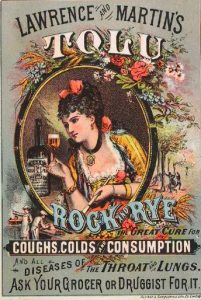
However, then as now, health was big business. Doctors and other enterprising individuals concocted potions of dubious value which they advertised as Patent Medicines These mostly contained opium or alcohol in a sugary syrup which at least made their patients feel better whilst leaving the disease unaffected.
Steven’s Consumption Cure, as it was titled, naturally made headlines across Europe and simultaneously caused consternation amongst the medical profession who quickly moved to shut him down as a charlatan and a quack. Doctors and their allies in the Patent Medicines business had a vested interest in selling their patent medicines for incurable diseases – some might think that nothing much has changed.
A fascinating and very readable account of Steven’s battle with the medical establishment and eventually even the British government can be found here: https://www.ncbi.nlm.nih.gov/pmc/articles/PMC1279998/
So, moving on to the present day, there are now a plethora of studies that show just how right the South African tribal doctors and Charles Stevens were. The heart-shaped velvety leaves of the pelargonium might well hold the answer to the treatment of multi-drug resistant diseases like bronchitis which kills millions of people every year and can no longer be routinely treated with antibiotics.
It was thought that traditional uses of pelargonium species for symptoms such as diarrhoea and dysentery were due to the astringent nature of their roots but recent research has shown that it is the its ant-bacterial, anti-viral and anti-fungal properties that fight the actual causes of the conditions rather than the effects.
Like many other plant-based medicines, pelargonium is what is known as an ‘intelligent’ remedy – it does not affect the whole body but, in the nature of holistic therapy, works with the body to fight and overcome disease. Containing more than 65 identified phytochemicals known to fight viruses, bacteria, inflammation and boost the immune system, pelargoniums are at the forefront of current research into the use of plant-based medicines as we enter an age when synthetic drugs are becoming ineffective due to overuse.
As The National Center for Biotechnology Information (a US institution which describes itself as ‘advancing science and health by providing access to biomedical and genomic information) says on its website:
“Studying herbs such as P. sidoides for effects on the non-specific immune system may lead to the identification of novel chemical structures on which newer therapeutic agents can be derived and provide additional insight into the mode of action at the molecular level. This example provides a compelling argument for continuing the exploration of Nature and traditional medical systems as a source of therapeutically useful herbal medicines which satisfy current criteria of quality, safety and efficacy for an evidence-based therapy.”
And elsewhere: “This example provides a compelling argument for continuing the exploration of Nature and traditional medical systems as a source of therapeutically useful herbal medicines.”
You won’t be surprised to know that there are lots of patents pending on the use of pelargonium by Big Pharma.
Jasmine – The Essential Oil of Happiness
Edited: November 13, 2022
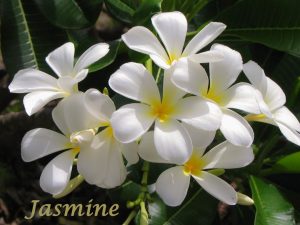
Guess what, the natural fragrance of flowers makes us happy!
We knew that already, right? Yes, but since 2010 we have known it for sure because the scientists – more specifically, the biochemists of Ruhr University in Germany – told us it’s so. (Yes, a little irony here).
But this really is exciting stuff. Their research showed that the jasmine scent molecules when breathed in are transmitted from the lungs to the blood and then penetrate the brain. The chemicals don’t have to be ingested to be effective. And that came as a surprise to the worthy biochemists – even if aromatherapists have telling people this for years.
Our brain cells send chemical messages across the brain and the nervous system, regulating it by exciting or inhibiting nerve responses through the spinal cord and throughout the body. These chemical messages are carried by neurotransmitters of which GABA (Gamma-aminobutyric acid) is one that regulates the communication between brain cells by inhibiting or damping down of neuron activity.
There has been a great deal of research into the role of GABA in the brain. It helps us to control our behaviour and thoughts by reducing fear, anxiety and stress when the neurons become over stimulated. Lower than normal levels of GABA in the brain have been linked to schizophrenia, depression, anxiety and sleep disorders.
Importantly for anyone interested in aromatherapy and the holistic approach to health, certain fragrances have now been proven by biochemists to enhance the effect of GABA on nerve cells helping to soothe, relieve anxiety and promote rest. Indeed, jasmine proved to be as effective as strong sedatives such as benzodiazepines which are the world’s most prescribed drugs, causing serious side-effects such as depression, hypotension, muscle weakness and impaired coordination.
In the words of Prof. Dr. Hanns Hatt who discovered that the two fragrances Vertacetal-coeur (VC) and the chemical variation (PI24513) have the same molecular mechanism of action and are as strong as the commonly prescribed barbiturates or propofol.
“Applications in sedation, anxiety, excitement and aggression relieving treatment and sleep induction therapy are all imaginable. The results can also be seen as evidence of a scientific basis for aromatherapy.”
If you or anyone you care for is experiencing the effects of stress, anxiety or insomnia, ask your aromatherapist to make you up a massage oil with jasmine, or put some in your diffuser or oil vapouriser. Even sufferers from neurological conditions such as MS or Parkinson’s who often react badly to sedatives, may be helped by this research.
So, when we fill our house with the divine scent of sweet peas, roses and jasmine, we know we are breathing in happiness and de-stressing in the healthiest way imaginable.
Chicory – wild blue beauty
Edited: November 13, 2022
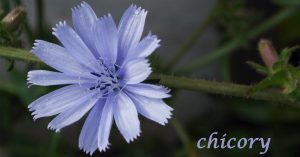
No-one who has seen the perfect sky-blue flowers of the chicory plant can ever forget them. A tall woody perennial, it is native to Europe where is grows along roadsides and dry field margins and has been a valued medicinal plant for centuries. It now grows happily on every continent where all parts of the plant are used in cuisine and medicine.
Famous as a caffeine-free addition to or substitute for coffee, the chicory root has so much more to offer to the herbalist. It is a valuable digestive aid and can help to reduce stomach acid, soothing acid reflux and aiding digestion. An extract from chicory root called inulin is used in modern medicine as a sweetener valuable in the treatment of diabetes, and as a tonic or cleanser for the liver. Related to the dandelion, chicory is valued for its young leaves and blanched buds which add the bitter flavour prized by Ayurvedic practitioners and so often lacking in the Western diet. The roots of the chicory plant are a treasure trove of prebiotics and biochemicals that treat and balance our bodies. They were traditionally grown as foraging for domestic animals who, like us, benefit from nature’s pharmacy.
This summer look out for the lovely cerulean blue flowers along the roadsides and hedgerows and wonder at all the benefits this common plant has to offer us.
Another reason not to use toxic sprays and chemicals to eradicate our native and naturalised plants.
(A version of this post was first published on our Facebook page in June 2018)
Emotional Release Through Aromatherapy Massage
Edited: November 13, 2022

Hurting minds create hurting bodies.
The strong link between our emotions and our physical bodies has been recognised and acknowledged for centuries.
When we are happy we feel uplifted, light, relaxed. We are ready to dance and sing, our bodies open and prepared to embrace the world.
When we feel depressed or angry our bodies close and retreat, the muscles tighten, and we withdraw into ourselves. We are alert but defensive.
What hasn’t been recognised until more recently is the long-term effect of trauma (including PTSD) on our physical bodies. Loss, anger, resentment, loneliness, even jealousy and rejection: they hurt. We feel it deeply in the very tissues of our bodies and we react instinctively by withdrawing physically and emotionally. And because it hurts us to remember, we suppress those feelings by excluding and trapping them in our minds and in our physical bodies.
Perhaps you have experienced an overwhelming sense of relaxation and peace after massage therapy. Some people are filled with grief or intense feelings of loss or love. It is as though our musculature itself holds memories for us – massage enables us to release those memories and to acknowledge and work with them in a safe space. This is known as emotional release.
Most of us are aware of the powerful effect of fragrance on our brains. The merest whiff of a certain perfume or a cooking aroma can ignite an explosion of emotions and memories.
The signals sent by the unique molecular structure of every oil directly to the limbic system which controls our emotions and memory, combined with our own olfactory memory – this is a powerful combination. Learning to work with it is an important part of our work as clinical massage therapists.
(This post was first published on our Facebook page on 21/6/2018)
Carrot Seed Oil
Edited: November 13, 2022
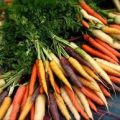
My mother always told me that eating carrots would help me see in the dark. She was right – she was usually right. Rich in Carotene and Vitamin A, the roots are indeed beneficial to the eyes and are effective antioxidants.
But carrots have so much more to give us. Carrot Seed oil has incredible properties that are only now being understood by modern science. The mild, earthy sweetness of Carrot Seed produces a powerful yet well-tolerated oil with a wide range of healing properties.
Continue reading …
 Accredited school
Accredited school



 We are celebrating 32 years of sharing the message about holistic healthcare and we would love you to help us spread this message further – educating those who are interested in body and mind medicine.
We are celebrating 32 years of sharing the message about holistic healthcare and we would love you to help us spread this message further – educating those who are interested in body and mind medicine. We know them as geraniums. Those glorious bright red staples of our summer bedding and window boxes with their velvety, scented leaves and ability to withstand the driest of summers, they are popular all over Europe and have even been elected the Swiss national plant. However Pelargonium Graveolens (to give it its Latin name) is a fairly recent immigrant, only arriving in Europe from its native South Africa in the 17th century.
We know them as geraniums. Those glorious bright red staples of our summer bedding and window boxes with their velvety, scented leaves and ability to withstand the driest of summers, they are popular all over Europe and have even been elected the Swiss national plant. However Pelargonium Graveolens (to give it its Latin name) is a fairly recent immigrant, only arriving in Europe from its native South Africa in the 17th century.



